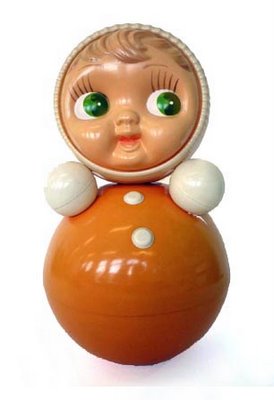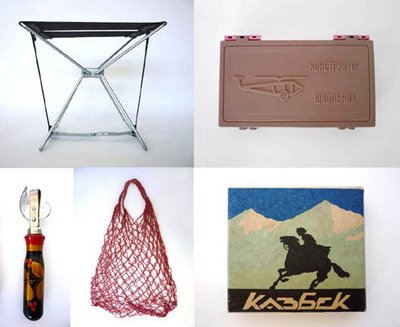Extinct: Products from the Soviet State Store
 Soviet consumer products always reminded me of weeds. Cheap, anonymous, notorious for their clunky robust look, they proliferated in great numbers at all levels of Soviet society. Like the Soviet State itself, it seemed they were destined to live forever.
Soviet consumer products always reminded me of weeds. Cheap, anonymous, notorious for their clunky robust look, they proliferated in great numbers at all levels of Soviet society. Like the Soviet State itself, it seemed they were destined to live forever.Once Russia turned capitalist in the early 1990s, it was only a matter of time before “the weeds” got cleared out. Presently, most Soviet products are extinct, or at least endangered; perhaps they still could be found on flea markets, or far in the provinces. We picked them at random during our early visits to Russia, driven, in part, by collectors’ instinct, in part – by a desire to amuse our American design colleagues.
Today, these products may still amuse someone, but their unpretentious simplicity can also teach us a few design lessons. Eventually, they will pass into the realm of historical artifacts. In November 2008, part of our collection has been presented in a small exhibition at KIOSK Gallery in New York City. A few highlights are shown below.



9 Comments:
I had one of those dolls!! Wonder if they were sold in Norway or my dad ( a sailor) bought it abroad
/Anders
I HAD ONE OF THOSSE DOLLS IN RUSSIA!!!!!! I want one now.
I had the can opener and the knitted bag as well.
The brown box is the constructor playset, but I dont know what the other 2 are.
The other two are a folding chair and a cigarette pack.
Ha - cute - I had the can opener, the chair and the bag. All that stuff had been ridiculed so often for the wrong reasons.
It was simple, hardly ever broke, and if it did brake it could be fixed easily.
Where is this Kiosk Gallery of which you speak?
Makes more sense to ridicule crappy Chinese imports, and especially products which are designed to be disposable. The attempt to be self-sustaining and independent, and to build everything to last at least a lifetime, if not several, is admirable.
They are not extinct, my wife bought one of those couple of months ago when she was visiting her family
We have that doll, it's red! My Russian SIL sent it to us.
For those interested in the objects shown in the composite picture, they are (clockwise from top right):
1. Folding Stool.
In a matter of seconds, this curious contraption could be transformed from a tangle of metal brackets into a comfortable, lightweight fisherman’s stool. Every detail of this stool is generated with pure engineering and production in mind, with complete disregard of any “design” considerations. Precisely because of that, the object has a considerable design appeal.
2. Erector Set.
Metal erector set, a popular toy with many Soviet boys, is presented in a solid plastic box, with graphic treatment reminiscent of Russian Constructivism. Somewhat incongruous pink and beige color scheme is probably accidental. Boxes’ color varied because of available granules of plastic, which factories often did not keep consistent from week to week.
3.Kazbek Cigarettes
Just like a bottle of Russian vodka, this pack of cheap, filter-less, strong cigarettes became known as one of the iconic objects of simple Soviet lifestyle. The origin of appearance of a shadowy Caucasian horseman and the mountains of Kazbek on a pack of Russian cigarettes is unclear.
I am not sure if these are still produced in Russia, but after years of wars in Chechnya and Ossetia, this would seem unlikely.
4.Shopping bag (Avoska).
The shortages of food and many household goods in the Soviet Union were legendary, while plastic shopping bags did not exist. If citizens run into some useful food items in the store or on the street, they had to worry about packing and carrying their find away.
The avoska (literally, a just-in-case bag) was very lightweight and compact., made of thin cotton netting. People would always carry one in their pocket or purse, just in case.
Ironically, starting from 1990s, the avoska has been adopted in the consumer paradise of Western Europe as environmental alternative to plastic bags.
5.Can Opener.
This ubiquitous object was the only opener available to generations of Russians. One curved blade of this dependable device is for popping up beer bottles; another – for opening of various kinds of tin cans. Usually, this type of openers would have a plain wooden handle. This one has a special handle, done in a traditional lacquer décor of Khohloma. The opener was thus turned into a “Russian Souvenir”, probably intended for foreign tourist consumption.
For me, this small object possessed an emblematic quality of entire Soviet Union’s design effort: its naïve combination of unadorned utility with forced national identity. In 1992, I planned to put it on the cover of my book "New Russian Design", which was then being published by Rizzoli. The editors rejected my choice, thinking that the opener was too uncomely.
These descriptions are from the labels for the Extinct show, which has closed down on Nov. 19.
Post a Comment
Subscribe to Post Comments [Atom]
<< Home